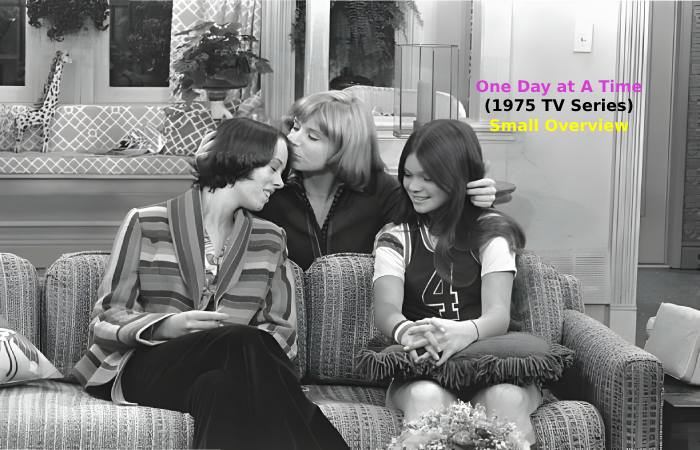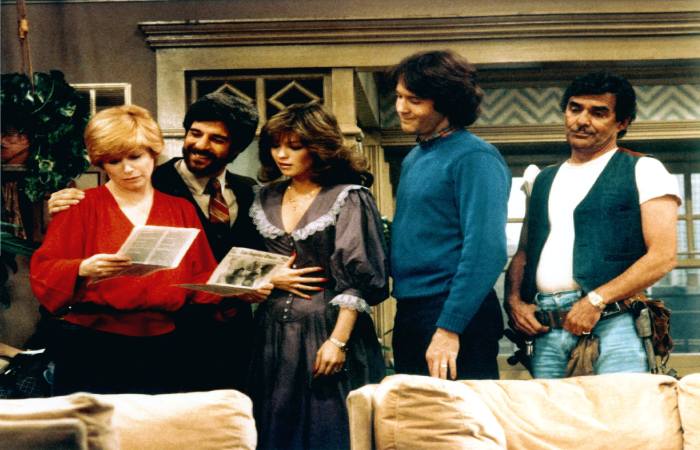In the 19th century, American TV series were very close to the public. They were interested in watching TV series. The 1970s were a transition period in several media, including television, mainly because of producer Norman Lear. His television programs addressed racism (All in the Family), focused on Black families (Sanford and Son, The Jeffersons), and examined the difficulties a divorced mother faces in raising her children. The original cast of One Day at a Time (1975 TV series), a television series that focused on precisely the same topic, was led by Bonnie Franklin.
The series was made by Whitney Blake and Allan Manings, a husband-wife writing duo who had both performed as performers in the 1950s and 1960s. Whitney Blake’s real-life experiences as a single mother after her first marriage, raising three children—among them the future actress Meredith Baxter—served as the basis for the television series.
Table of Contents
One Day at A Time (1975 TV Series) Small Overview

“One Day at a Time” is notable for being a ground-breaking sitcom that humorously yet poignantly addressed the Day’s pressing issues. The program follows Julie and Barbara Cooper, Ann Romano’s two children, who experience the highs and lows of living in Indianapolis. Ann Romano is a divorced mother.
Ann is a robust and determined lady committed to achieving her independence and maintaining her family unit. The show’s cast brings poignant moments and layers of humorous appeal, including Ann’s ex-boyfriend, David Kane, and building supervisor, Dwayne Schneiderino. “One Day at a Time” is still regarded for its progressive spirit and for having perfectly encapsulated the mood of the Day.
Production of One Day at A Time (1975 TV Series)
The show was filmed in Hollywood in front of a studio audience for the duration of its run. It remain recorded initially at CBS Television City. The show started filming at Metromedia Square soon after its debut and stayed there until 1982. The series was recorded at Universal Studios between 1982 and 1984.
One Day at a Time, a hybrid comedy/drama of the “dramedy” genre, frequently addressed severe topics in life and relationships, especially those connected to second-wave feminism, like many of the sitcoms created by Norman Lear. Stories about marriages, births, and other significant life events usually took the form of two-, three-, or four-part episodes.
Theme Music and Opening Titles of One Day at A Time (1975 TV Series)
Composer Jeff Barry and his wife Nancy Barry of Brill Building wrote the theme song for One Day at a Time, This Is It, which remains recorded by recording artist Polly Cutter. Initially, a video clip with Ann, Julie, and Barbara eagerly moving into their new house played over the opening credits. Later, clips of the entire cast from earlier episodes made up most of the opening credits sequence.
The Series Runs Between 1975 -1984 of One Day at a Time (1975 TV series)

In this series, 9 seasons and 209 episodes are there
Cast and Characters in One Day at a Time (1975 TV series)
Ann Romano, played by Bonnie Franklin, is a strong and self-reliant divorced mother of two who navigates life while looking for love and professional success.
Julie Cooper, played by Mackenzie Phillips, is Ann’s rebellious older daughter who struggles with everything from marital woes to teenage angst.
Barbara Cooper, played by Valerie Bertinelli, is Ann’s younger daughter and more reserved and sensible than her sister.
Pat Harrington Jr. plays Dwayne Schneider, the eccentric yet endearing superintendent of the building who becomes the family’s dependable friend.
Richard Masur plays David Kane, Ann Romano’s gorgeous boyfriend who marries her and brings warmth and compassion into the family.
Theme Music and Opening Titles of One Day at A Time (1975 TV Series)
Ann Romano, a divorced mother, relocates to Indianapolis with her teenage daughters, rebellious Julie and wisecracking Barbara, from their Logansport, Indiana, home. Ann often finds it difficult to uphold her motherhood while giving her girls the independence she could never enjoy as a young woman. The building superintendent, Dwayne Schneider, frequently gives Ann and the other tenants unsolicited counsel.
Ann starts dating David Kane, her divorce attorney, and the two remain engaged. However, on their wedding day, David declares he wants children, and Ann says she doesn’t, so they call off the ceremony.
The show centers on Ann’s struggles as a single mother and professional woman after David accepts a job in Los Angeles. It also highlights the girls’ growing pains, making Schneider a more accepted family member. Ann and the girls’ tense relationship with Ed’s new wife, Vickie, and Ed’s relationship with Ann’s former spouse gradually improves. After completing their high school education, Julie and Barbara enter the workforce. Ultimately, Julie weds Michael Lembeck’s character, Max Horvath, a flight attendant.
When Alex (Glenn Scarpelli), the orphaned son of Ann’s late boyfriend Nick (Ron Rifkin), comes in, the apartment’s gender relations shift. Ann partners with her former coworker Francene Webster (Shelley Fabares) to launch her advertising company.
Later in the life of the show, Ann’s mother Katherine (Nanette Fabray) comes nearby, Barbara marries dental student Mark Royer (Boyd Gaines), and Julie gives birth to daughter “Little Annie” Horvath. Later on, Ann weds Sam, the father of Mark Royer (Howard Hesseman).
In the penultimate episode, Ann leaves her daughters in Indianapolis to raise their own families to accept a job offer in London. In the series finale, Schneider moves to Florida to care for his niece and nephew.
Conclusion
We try to give information to our audience about One Day at a Time (1975 TV series) despite a few casting flaws. Norman Lear has demonstrated his understanding of chemistry once more with One Day at a Time. Comedy is always equal parts top-notch characters, screenplay, and director.
Related posts
Hot Topics
5 Pre-Workout Mistakes You’re Probably Making
5 Pre-Workout Mistakes You’re Probably Making Pre-workout supplements are among the methods that fitness enthusiasts embrace in pursuit of optimal…
How to Feel More Relaxed
In our fast-paced, constantly connected world, finding moments of relaxation can seem like a luxury we can hardly afford. Yet,…


